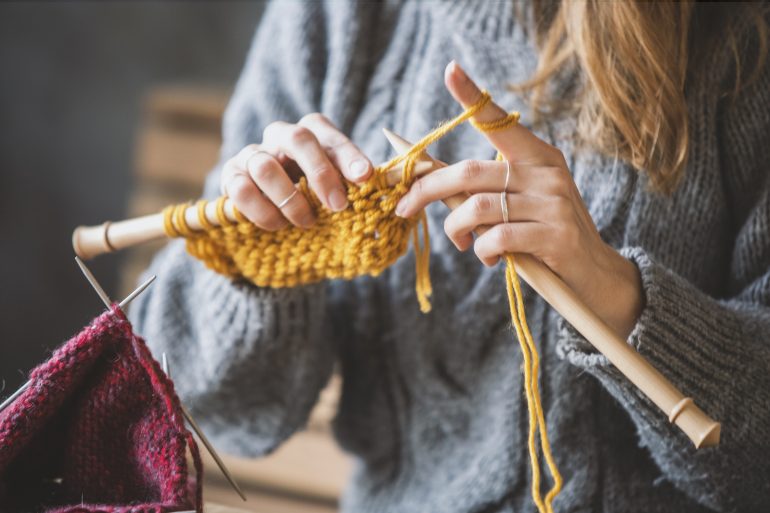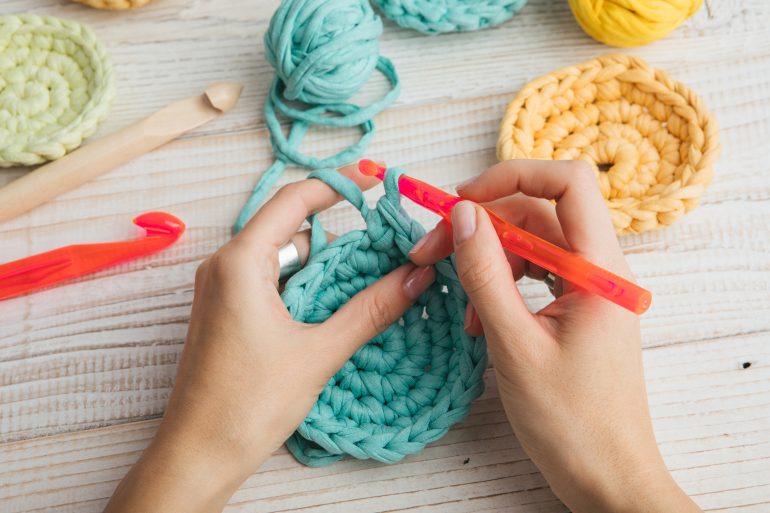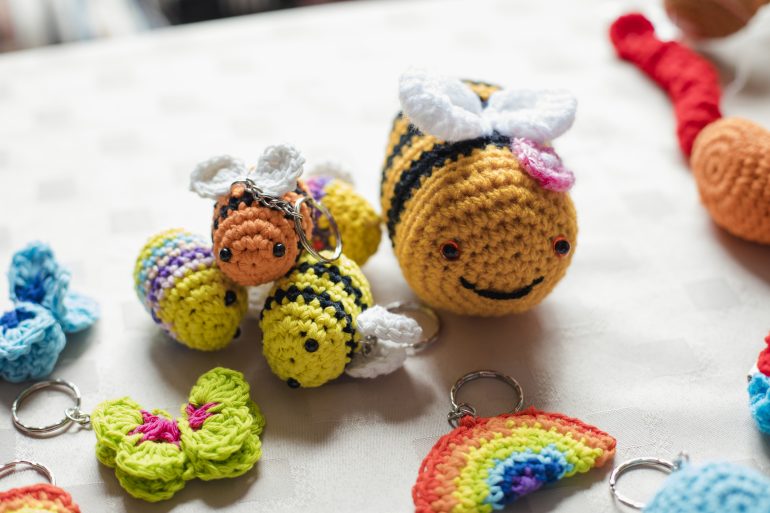From scarves to soft toys, baskets to blankets, crocheting can make them all with nothing but fibre and a hook. That’s because this simple, versatile craft creates a variety of textures, from soft and supple fabrics to sturdy, firm materials for three-dimensional objects.
Sometimes called a fibre craft, at other times as a form of needle art, its stitches are sturdier than those of kitting, yet intricate enough to produce lace.
But what is crocheting in practice? What do you need to crochet and how can one choose what to crochet for beginners? If you’re ‘yarning’ for answers, read on.
What is Crocheting?

Crochet close-up (Credit: LukaTDB via Getty Images)
Crocheting is the process of using a crochet hook to interlock loops of yarn, thread, or other fibres, creating fabric or other items. Unlike knitting, which uses two needles, crocheting employs a single hook, making it a unique craft in its own right.
The art of crochet can be categorised into two primary types: yarn crochet, which uses larger hooks and yarn to create items like blankets and sweaters; and thread crochet, which uses fine thread and steel hooks to produce delicate items such as lace doilies. Despite the differences, most patterns can be adapted to either technique.
Types of Crocheting Explained

Stunning Irish crochet, from c.1900 (Credit: NNehring via Getty Images)
Crochet encompasses a variety of techniques, each offering distinct styles and textures, ranging from delicate lacework to freeform artistry.
Filet Crochet
This technique traditionally uses thread but can also employ yarn, creating a square net through a combination of double crochet and chain stitches. Patterns form by filling in parts of the grid with double crochet. Filet crochet designs are commonly charted on a square grid.
Irish Crochet
This lace style features dense, often floral motifs connected by fine crochet netting with delicate picots. These motifs are frequently worked over a foundation cord, giving them a raised appearance.
Freeform Crochet
This technique emphasises colour and texture over structured patterns, creating designs that flow organically.
Tunisian Crochet
Using a long crochet hook resembling a knitting needle, Tunisian crochet involves picking up stitches from right to left and then working them off one by one in the opposite direction.
What Do You Need to Crochet?

Crochet hook & yarn (Credit: Ruth Hornby Photography via Getty Images)
To answer the question what do you need to crochet, the answer is actually very little.
Crochet Hooks
The name ‘crochet’ is derived from French, in which it means ‘hook,’ providing the first hint that this is the craft’s main tool. Crochet hooks come in various sizes, materials, and shapes. Aluminium and plastic hooks are standard for most projects, while steel hooks are used for finer threads. The difference between UK and US sizes is noteworthy, with hooks also varying by shape: inline hooks feature a straight shaft and throat, while tapered hooks have a narrower throat. Tunisian hooks are longer, resembling knitting needles.
Other Crochet Tools
Crocheters rely on various tools beyond hooks. Scissors cut yarn or thread, while measures, needles, pins, and stitch markers assist in maintaining pattern consistency. These tools help create precise and durable crocheted items.
Materials
Crocheting materials include both yarn and thread, each serving different purposes. Thread crochet creates delicate items like lace doilies. It’s a thinner strand of yarn, which can be mercerised for a high polish or left unmercerised for a softer finish. Yarn, spun from various materials, offers a range of textures.
- Animal Fibres: Wool, alpaca, cashmere, mohair, yak, and silk are common fibres, each providing unique qualities.
- Plant Fibres: Cotton and linen are staples, with bamboo and hemp gaining popularity, often labelled as ‘Tencel’ or ‘Lyocell’.
- Synthetic Fibres: Acrylic and polyester provide affordable options, suitable for a variety of projects.
Yarn is categorised by weight, ranging from fine to bulky, influencing its use in different patterns. For reference, the open side of the yarn is called the tail end, and the side closer to the ball is called the working yarn.
Basic Crochet Techniques

Crochet in bright pastel colours (Credit: Fly_dragonfly via Getty Images)
Crocheting begins with a slip knot and a foundation chain, providing a base for subsequent stitches. Here is a more detailed look at each fundamental crochet stitch:
Slip Knot & Chain Stitch
This is made using two loops, using the first one to secure the other, not unlike tying shoelaces. First the yarn is formed into a loop, crossing the tail end over the main strand and holding it there. The main strand is then pulled through from behind the loop until a second loop around the diameter of a thumb is formed. The crochet hook is inserted into the second loop before using the first one to tighten it. The chain stitch repeats this process to form a series of interconnected loops, resulting in a chain that serves as the groundwork for other stitches.
Slip Stitch
The slip stitch is a basic yet essential crochet technique, often used to join rounds, create seams, or move along a row without adding height.
Single Crochet
The single crochet stitch creates a firm and dense fabric, ideal for projects requiring structure.
What is Double Crochet?
In terms of what is a double crochet, this stitch produces a more open and airy fabric, making it suitable for lightweight garments or lace-like patterns.
Crochet Patterns

Incredible crochet pattern (Credit: Katrin Ray Shumakov via Getty Images)
Crochet patterns can seem daunting at first, but they are simply guides that use symbols and abbreviations to instruct crafters. For beginners, starting with simple patterns is a great way to learn and gain confidence.
Troubleshooting Common Issues

Cool crochet keyrings (Credit: SolStock via Getty Images)
Crocheters may encounter problems such as uneven edges or incorrect stitch counts. These issues can often be remedied by counting stitches regularly to ensure consistency. It’s also vital to check gauge. Every pattern specifies a gauge, meaning the number of stitches and rows it should have. Keeping track of this prevents mistakes.
What to Crochet for Beginners

Crochet blanket (Credit: Cyndi Monaghan via Getty Images)
For beginners, straightforward projects like scarves, dishcloths, and blankets are ideal. Scarves introduce essential stitches such as single and double crochet, while dishcloths help refine tension control. These manageable projects build confidence and skills, laying a solid foundation for future endeavours.
Crocheting Explained in a Nutshell

A beautiful crochet throw (Credit: DaydreamsGirl via Getty Images)
So, that’s crocheting explained in a nutshell. And, as we’ve seen this flexible craft can make everything from delicate trinkets to snuggly blankets. This guide has covered everything from the basics of what is a double crochet to selecting the right materials and tools, enriching your journey into the world of crochet.












